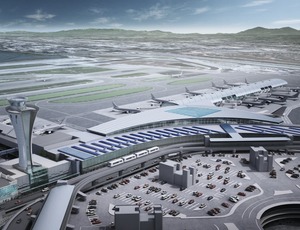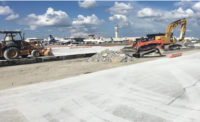

Surface transportation designers and builders are adopting a more system-based, holistic approach to infrastructure that emphasizes sustainability and place-making, not merely mobility. And so are airports.
For years now, airport leaders have agreed that meeting LEED standards is a start but not enough for sustainability goals. In addition to Chicago O'Hare International Airport's "Sustainable Airport Manual," which solicits input from peers in the U.S. and around the world, most major domestic airports also have their own voluntary guidelines.
The latest guidelines issued by San Francisco International Airport (SFO) will inform some $4.2 billion worth of work planned for the next eight years, including a revamp of Terminal 1 and baggage-handling facilities and a new hotel and air-traffic-control tower. "We are looking at sustainability not as a list of boxes to check off," says Geoffrey Neumayr, SFO associate deputy director. "Forty years down the road, what will people say about the airport?"
The manual lists mandatory compliance items as per state, federal and city codes, plus LEED standards, for the design and construction of infrastructure. However, beyond these benchmarks, it offers suggestions, tools and metrics to not only optimize energy use but also maximize the resiliency and longevity of facilities and the comfort and safety of people. It also considers social and ethical issues.
"There are recommended actions, but, in terms of implementation, we talk more about the process of thinking about impacts and life-cycle assessment," says Leo Roy, principal at VHB Inc., which helped SFO create the guidelines. "We outlined criteria and targets, but it's up to the teams to unleash creativity."
To promote such flexibility, design-build will factor into many project bids. But no matter the contract, "we have adopted a holistic way of delivering facilities," Neumayr says.
It's not just the major hubs embracing life-cycle, long-term thinking for their infrastructure. Roy notes that a recent RFP issued by a general aviation airport in Florida also includes design guidelines. "I think we are seeing airports of all sizes begin to establish frameworks for the types of projects they want to have," Roy notes.
Flying Forward
The U.S. airport-infrastructure industry is happy to differ from its transportation counterparts ever so slightly regarding their respective funding situations. After 9/11, airline bankruptcies and the recession, now “the industry is getting healthier,” says Liying Gu, managing director of finance and research for Airports Council International-North America.
"The state of the airport trust fund is in a much better position," Gu says. "It bottomed out in 2009 when the uncommitted balance was only $299 million. But now traffic is coming back, airlines are raising base fares, and there's an increase in international traffic—all that is driving more revenue into the fund."



Post a comment to this article
Report Abusive Comment